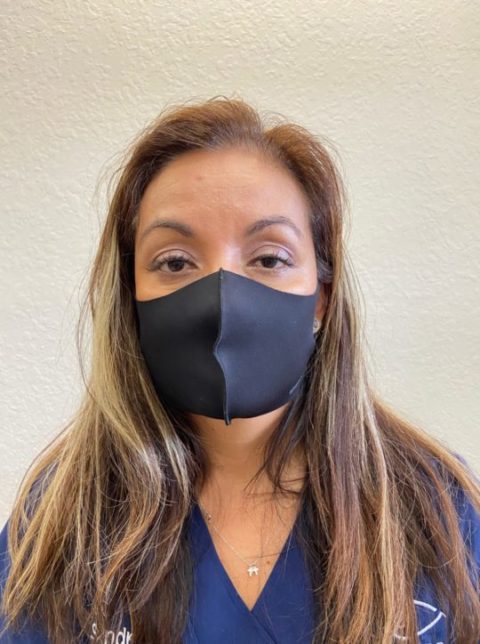Welcome to the Cornea by Kane blog, your trusted source for an honest opinion about your eyes.
Today, let’s talk about the very common problem of how wearing a mask COVID can affect your dry eyes and some helpful tips to alleviate it.
Mask Associated Dry Eye (MADE)
Mask Associated Dry Eye or MADE was as recently described by Moshifar et. al. in Ophthalmology and Therapy (09/2020) at the Centre for Ocular Research and Education (CORE). The article was posted on EyeWire (8/31/2020) about a common reason for eye irritation and blurry vision during the coronavirus pandemic. It is also a reason why dry eye patients may be noticing worsening of their symptoms. This condition is probably more common than eye doctors are aware. It may contribute to increased eye irritation and decreased visual acuity or vision quality. The symptoms of MADE overlap with the symptoms of dry eye. These include intermittent blurry vision, foreign body sensation, burning, scratchy or gritty feeling eyes, and eye fatigue.
How does wearing a mask lead to symptoms of dry eye?
Air movement from breathing while wearing a mask can force the air not only out the sides and bottom of the mask but also up and out the top of the mask. Drafts out the top of the mask can lead to increased irritation and blurry vision by drying the cornea or front part of the eye. Frequent air movement over the eye leads to more rapid evaporation of your tear film, similar to having the air conditioning vent blow over the eye while driving in a car.
What are the symptoms of MADE?
Symptoms of MADE may vary from person to person, however many people may notice intermittent or constant blurry vision, eye irritation, eye redness, gritty or sandy feeling in the eyes, increased tearing or watering, and itchy eyes. If you already have dry eye, you may notice your normal symptoms of dry eye are worse than usual. This can also lead to touching your eyes and rubbing your eyes which could increase the spread of germs through your conjunctiva (eye skin covering). It is important to try to treat the symptoms of eye irritation so that you avoid touching your face (especially if you haven’t had time to wash your hands).
What are some solutions for MADE?
Having an Appropriate Fit
Making sure that your mask fits well is a reasonable first step. Placing a strip of paper tape (1 inch wide medical paper tape is available at most pharmacies) along the top border of the mask can help block air from flowing up and over the eyes. A tip here is to first stick the piece of tape onto your clothing a few times to make it less sticky so it will come off your face easier. Additionally, some masks can be supported with a thin strip of wire or metal that can be bent to the contour of your nose and face to reduce air escape out the top.
Artificial Tears
Lubricating artificial tears are helpful for coating and protecting the surface of the eye. Personal preference will dictate which tear you like best and it should be used 4-6 times a day (breakfast, lunch, dinner, and bedtime for example) to augment your tear film. Tears in a bottle may contain preservatives which can also be irritating to the eye over time. For that reason, I normally recommend preservative free artificial tears. See the blog post on 5 quick tips for dry eye for my favorite tear recommendation.
Minimize Time on Electronics
TV, computers, tablets, and smart phones and reading can all make MADE worse. When you use these devices your blink rate slows down which puts your tear film at greater risk of evaporation. Remember to take regular breaks where you close your eyes all the way when you are using electronics or reading for a prolonged period of time.
Warm Compress
Warm compresses can be a quick way to boost the oil layer in your tear film and stabilize the rate of tear evaporation. A warm compress eyelid masks is readily available in the drug store and can be reusable and heated in the microwave. 10 minutes a day of a warm compress may help with some of the symptoms of MADE.
Additional options
If you have tried the above suggestions and are still having trouble with MADE, call your eye doctor and consider coming in for an evaluation. There are additional options that can be considered after your clinic evaluation such as LipiFlow, oral supplements, and punctal plugs, however these treatments an evaluation with a dry eye specialist or ophthalmologist. As wearing a mask is likely a recommendation that will stay with us for some time, don’t ignore the symptoms of mask associated dry eye. If you continue to suffer from MADE, call your eye doctor or ophthalmologist for an eye exam to discuss your options today.
I’m Dr. Kane, and that’s my take on it.
At Tailored Eyes, we will perform a thorough evaluation of your eyes and together formulate a customized treatment plan to meet your vision needs.
For more information or to book an appointment please call the office at 941-499-1570 or email us at info@tailoredeyes.com.
Steven Kane, MD, FAAO is a Cornea, Cataract, and Refractive Surgery specialist with Tailored Eyes in Sarasota county Florida. He proudly serves the people of Venice, South Venice, Sarasota, Plantation, Osprey, Nokomis, Laurel, Siesta Key, Casey Key, Bradenton, Lakewood Ranch, Anna Maria, Palmetto, Ellenton, St. Petersburg, Englewood, North Port, Punta Gorda, Port Charlotte, Charlotte Harbor, Manasota Key, Arcadia, Fort Myers and Cape Coral.

